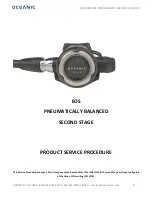
Sauter GmbH
Tieringerstr. 11-15
Tel: +49-[0]7433- 9976-174
D-72336 Balingen
E-Mail: [email protected]
Fax: +49-[0]7433-9976-285
Internet: www. sauter.eu
Instruction Manual
TU_US
TU_US-BA-e-1110
4
The physical constraints of the environment sometimes
determine a transducer’s suitability for an operation. Some
transducers are simply too large to be used in a confined
area. If the available surface area for contacting with the
transducer is limited, the usage of a transducer with a
small surface is required.
Measurements on a curved surface, in example an engine
cylinder wall, will require a transducer with an adapted
surface.
Temperature of the material: If exceedingly hot surfaces
are to be measured, high temperature transducers must be
used. These transducers are built with special materials
and techniques that allow them to withstand high
temperatures without being damaged. Additionally, care
must be taken if a “Zero adjustment” or a “Calibration to
known thickness” is being performed with a high
temperature transducer.
The selection of a proper transducer is often a matter of
tradeoffs between various characteristics. Sometimes it is
necessary to experience with a variety of transducers in
order to find the one that works well for a special
operation.
The transducer is the “business end” of the instrument.
It transmits and receives ultrasonic sound waves which the
instrument uses to calculate the thickness of the material
being measured. The transducer is connected to the
instrument via the attached cable and two coaxial
connectors. The transducer has to be installed correctly to
get reliable measurement results. Each plug must be fit
into the adequate socket in the instrument.
Below there are shown two photos and a short description
of the instruction use of a transducer.
The upper figure is a bottom view of a typical transducer.
The two semicircles are visibly separated in the middle of
the surface. One of the semicircles is conducting the
echoed sound back into the transducer. When the
transducer is placed against the material being measured,
this is the area directly beneath the centre of the measured
surface.
The below figure is a top view of a typical transducer.
It is pressed against the top with the thumb or the index
finger to hold the transducer in place. Only moderate
pressure is sufficient to keep it stationary. Its surface must
be placed flat against the surface of the material.
Table 3-1 Transducer selection
Mo-
del
Freq
MHZ
Dia
metr
mm
Measurement
range
Lower
limit
Description
N02 2
22 3.0mm
~
300.0 20 For
thick,high-
mm(in steel
)
40mm(grey
Cast iron
HT200)
ly attenuating
or highly
scattering
materials
N05 5 10
1.2mm
~
230.0
mm (in steel)
Φ
20mm×
3.0mm
normal
measurement
N05
/90°
5 10
1.2mm
~
230.0
mm(Stahl
)
Φ
20mm×
3.0mm
normal
measurement
N07 7 6
0.75mm
~
80.0
mm
(in steel
)
Φ
15mm×
2.0mm
For thin pipe
wall or small
curvative pipe
wall
HT5 5 14
3
~
200mm
(Stahl)
30
For high tem-
perature (lower
than 300°C)
measurement
3.2 Conditions and preparation of surfaces
At any kind of ultrasonic measurement, the shape and
roughness of the surface being tested are of paramount
importance. Rough and uneven surfaces may limit the
penetration of the ultrasound through the material resulted
by an unstable and therefore unreliable measurement.
The surface being measured should be clean and free of
any small particulate matter, rust or scale. The transducer
must be placed on a flat and even surface. To get it clean
it might be helpful to use a wire brush or a scraper. In more
extreme cases, rotary sanders or grinding wheels may be
used. Care must be taken to prevent surface gouging
which inhibits a proper transducer coupling.
Extremely rough surfaces such as the pebble-like finish of
cast iron will be measured quite complicated. These kinds
of surfaces comport to the sound beam like frosted glass
on light: the beam becomes diffused and scattered in all
directions.
In addition to this, rough surfaces account for an excessive
wear of the transducer, especially when it is “scrubbed”
along the surface. Transducers should be inspected time
by time if there are any signs of abrasion.
If the transducer is worn off on one side more than on the
other, the sound beam penetrating the test material may
no longer be perpendicular to the surface of the material.
In this case, it is difficult to exactly locate tiny irregularities
in the material, as the focus of the sound beam no longer
lies directly beneath the transducer.
4. Operation
4.1 Power on/ off
The instrument is turned on by pressing the
key.
If the instrument is initially turned on, the model type, the
manufacturer information and the serial number will be
displayed before entering the main measurement screen.
It is turned off by pressing the
key.





























